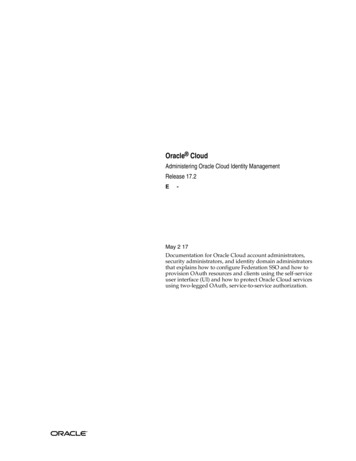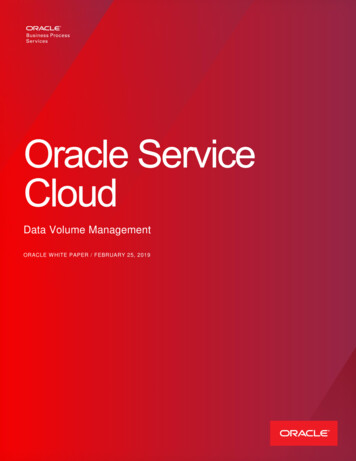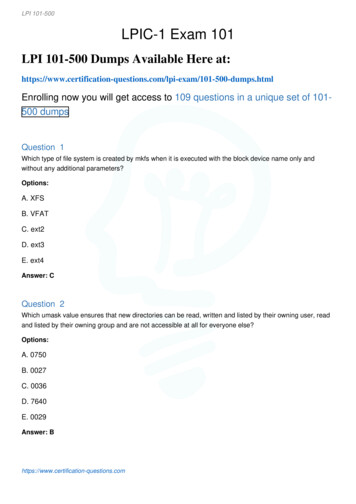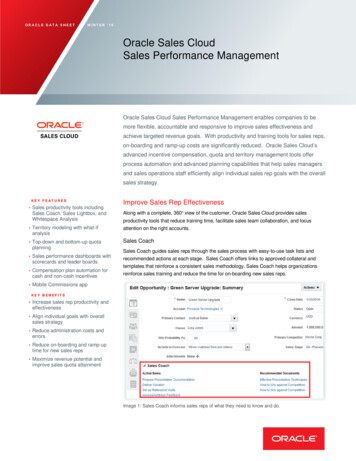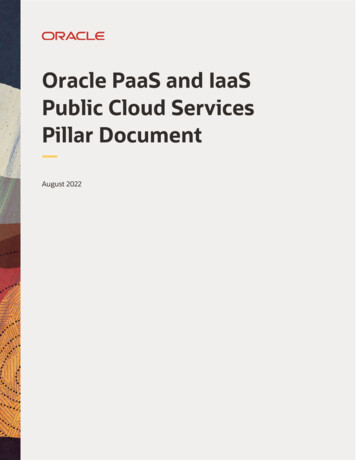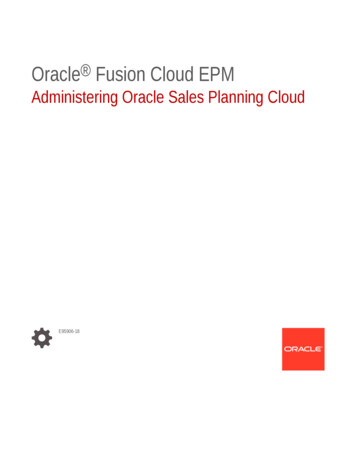
Transcription
Oracle Fusion Cloud EPMAdministering Oracle Sales Planning CloudE95906-18
Oracle Fusion Cloud EPM Administering Oracle Sales Planning Cloud,E95906-18Copyright 2018, 2022, Oracle and/or its affiliates.Primary Author: EPM Information Development TeamThis software and related documentation are provided under a license agreement containing restrictions onuse and disclosure and are protected by intellectual property laws. Except as expressly permitted in yourlicense agreement or allowed by law, you may not use, copy, reproduce, translate, broadcast, modify, license,transmit, distribute, exhibit, perform, publish, or display any part, in any form, or by any means. Reverseengineering, disassembly, or decompilation of this software, unless required by law for interoperability, isprohibited.The information contained herein is subject to change without notice and is not warranted to be error-free. Ifyou find any errors, please report them to us in writing.If this is software or related documentation that is delivered to the U.S. Government or anyone licensing it onbehalf of the U.S. Government, then the following notice is applicable:U.S. GOVERNMENT END USERS: Oracle programs (including any operating system, integrated software,any programs embedded, installed or activated on delivered hardware, and modifications of such programs)and Oracle computer documentation or other Oracle data delivered to or accessed by U.S. Government endusers are "commercial computer software" or "commercial computer software documentation" pursuant to theapplicable Federal Acquisition Regulation and agency-specific supplemental regulations. As such, the use,reproduction, duplication, release, display, disclosure, modification, preparation of derivative works, and/oradaptation of i) Oracle programs (including any operating system, integrated software, any programsembedded, installed or activated on delivered hardware, and modifications of such programs), ii) Oraclecomputer documentation and/or iii) other Oracle data, is subject to the rights and limitations specified in thelicense contained in the applicable contract. The terms governing the U.S. Government’s use of Oracle cloudservices are defined by the applicable contract for such services. No other rights are granted to the U.S.Government.This software or hardware is developed for general use in a variety of information management applications.It is not developed or intended for use in any inherently dangerous applications, including applications thatmay create a risk of personal injury. If you use this software or hardware in dangerous applications, then youshall be responsible to take all appropriate fail-safe, backup, redundancy, and other measures to ensure itssafe use. Oracle Corporation and its affiliates disclaim any liability for any damages caused by use of thissoftware or hardware in dangerous applications.Oracle, Java, and MySQL are registered trademarks of Oracle and/or its affiliates. Other names may betrademarks of their respective owners.Intel and Intel Inside are trademarks or registered trademarks of Intel Corporation. All SPARC trademarks areused under license and are trademarks or registered trademarks of SPARC International, Inc. AMD, Epyc,and the AMD logo are trademarks or registered trademarks of Advanced Micro Devices. UNIX is a registeredtrademark of The Open Group.This software or hardware and documentation may provide access to or information about content, products,and services from third parties. Oracle Corporation and its affiliates are not responsible for and expresslydisclaim all warranties of any kind with respect to third-party content, products, and services unless otherwiseset forth in an applicable agreement between you and Oracle. Oracle Corporation and its affiliates will not beresponsible for any loss, costs, or damages incurred due to your access to or use of third-party content,products, or services, except as set forth in an applicable agreement between you and Oracle.
ContentsDocumentation AccessibilityDocumentation Feedback1Welcome to Sales PlanningAbout Sales Planning2About Quota Planning1-1About Advanced Sales Forecasting1-2About Key Account Planning1-4Learning More About Sales Planning1-5Related Guides1-6Navigating in Sales Planning1-7Setting Up Your ApplicationImplementation Checklist2-1Creating an Application2-5About Sales Planning ApplicationsEnabling Essbase Hybrid Block Storage Option (BSO) Cubes31-12-62-6Configuring Quota PlanningEnabling Quota Planning Features3-1Configuring Quota Planning3-4Adding Custom MeasuresPost Configuration Tasks3-63-7Setting Substitution Variables for Quota Planning3-8Setting User Variables3-8Quota Planning Rules3-9iii
45Configuring Advanced Sales ForecastingEnabling Advanced Sales Forecasting4-1Configuring Advanced Sales Forecasting4-4Post Configuration Tasks4-4Importing Advanced Sales Forecasting Metadata and Data4-5Preparing Compensation Assumptions4-6Setting User Variables4-6Integrating Quota Planning and Advanced Sales Forecasting4-7Advanced Sales Forecasting Rules4-8Configuring Key Account PlanningConsiderations and Prerequisites5-1Enabling Key Account Planning5-1What Happens When You Enable Key Account Planning5-5Configuring Key Account Planning5-5Post Configuration Tasks5-6Importing Key Account Planning Metadata and Data5-6Setting User Variables5-6Integrating Quota Planning and Key Account Planning5-8Key Account Planning Rules5-9Key Account Planning CalculationsA5-12Importing DataImporting Quota Planning DataA-2Importing Advanced Sales Forecasting DataA-2Importing Key Account Planning DataA-3BPersonalizing Sales PlanningCIntegrating with Oracle Engagement CloudIntegrating Dimension Metadata from Oracle Engagement Cloud with Sales PlanningC-1Integrating Sales Data from Oracle Engagement Cloud with Sales PlanningC-2iv
Documentation AccessibilityFor information about Oracle's commitment to accessibility, visit the Oracle AccessibilityProgram website at http://www.oracle.com/pls/topic/lookup?ctx acc&id docacc.Access to Oracle SupportOracle customers that have purchased support have access to electronic support through MyOracle Support. For information, visit http://www.oracle.com/pls/topic/lookup?ctx acc&id infoor visit http://www.oracle.com/pls/topic/lookup?ctx acc&id trs if you are hearing impaired.v
Documentation FeedbackDocumentation FeedbackTo provide feedback on this documentation, click the feedback button at the bottom ofthe page in any Oracle Help Center topic. You can also send email toepmdoc ww@oracle.com.vi
1Welcome to Sales PlanningRelated Topics About Sales PlanningOracle Sales Planning Cloud provides an extensible framework for planning andmanaging sales performance. Related GuidesSee these related guides for more information about working with Oracle Sales PlanningCloud. Navigating in Sales PlanningReview these useful tips for navigating in Oracle Sales Planning Cloud.About Sales PlanningOracle Sales Planning Cloud provides an extensible framework for planning and managingsales performance.Using Sales Planning enables you to automate critical processes by eliminating spreadsheetsin key sales operations processes and improves collaboration for planning, modeling andreporting of sales quotas, attainment, and sales forecasts.Sales Planning is extensible using the EPM Cloud platform to further add additionalconfigurations and personalization into your sales planning application with customnavigation flows, dashboards, and infolets. Use tasks and approvals to manage the quotaplanning process. Use Groovy rules to customize even further for enhanced calculation andbusiness rules. Sales Planning can be integrated with Oracle Engagement Cloud – SalesCloud for pushing quota targets to incentive compensation or bring in actual attainment.VideosYour GoalWatch This VideoLearn more about Sales Planning.Overview: Take a Tour of Sales PlanningCloudAbout Quota PlanningThe Quota Planning business process offers top-down and bottom-up target quota planningby territory, product, account, or other custom dimensions. Use Predictive Planning and whatif scenario planning to explore and compare different quota scenarios for informed decisionmaking. Quota Planning builds best practices into its content, including its forms, calculations,dashboards, infolets, drivers, and measures.Quota Planning helps you plan reliable target quotas by engaging all of the participants of theprocess, for example, the VP of Sales, Sales Operations, Sales Managers, and Sales Reps.Set a target quota for the next year. Then, optimize your results by making adjustments byproduct, applying padding or seasonality, or performing predictive planning or what-if1-1
Chapter 1About Sales Planninganalysis. When the target is ready, planners perform top-down or waterfall planning toallocate the target quota throughout the hierarchy.If needed in your organization, you can also perform bottom-up planning to get quotacommitments from Sales Reps, allowing a collaborative approach. After the targetquotas are pushed up to the next level of the hierarchy and aggregated, you cancompare top-down and bottom-up results. Use the built-in dashboards to analyze andevaluate your quota plans with quota attainments.Enhance the planning process in your organization by adding additional measures,task lists, or approvals.VideosYour GoalLearn more about Quota Planning.Watch This VideoOverview: Quota Planning in OracleSales Planning CloudTutorialsTutorials provide instructions with sequenced videos and documentation to help youlearn a topic.Your GoalSee how to enable and configure QuotaPlanning in Oracle Sales Planning Cloud.Learn how to set variables, prepare actualand forecast data, and verify theconfiguration.Learn HowCreating and Configuring QuotaPlanning in Oracle Sales Planning Cloud TutorialAbout Advanced Sales ForecastingAdvanced Sales Forecasting provides a robust platform for the sales forecastingprocess, allowing multidimensional sales forecasting across territory, products,accounts, channels, or other custom dimensions.1-2
Chapter 1About Sales PlanningIt offers sales teams connected sales planning with integration between Quota Planning,compensation planning, and sales forecasts. With Advanced Sales Forecasting, you can planat the weekly or monthly level, and use a rolling forecast if your business requires it. It offersthese key features: Out-of-box best practice content for sales forecasting and analysis, including metrics,KPIs, and measures to help data-driven sales forecasting across the Sales hierarchy. Extensibility using the Planning Cloud platform, allowing additional configurations, suchas custom forms and dashboards, measures, dimensions, navigation flows, and Groovyrules for custom calculations. Ability to adjust forecast commitment at the territory level or detailed level (for example,by product or account) to facilitate collaborative data-driven forecast commitment. Predictive Planning to take the guesswork out of your forecasting. Oracle Smart View for Office, which provides a common Microsoft Office interfacedesigned specifically for Oracle Enterprise Performance Management Cloud services,including Oracle Sales Planning Cloud. Instantaneous aggregations and reporting using out-of-box reporting cube.Advanced Sales Forecasting ensures greater reliability in your forecasts, and accountabilityand collaboration between Sales Management and Sales Reps.VideosYour GoalLearn more about Advanced Sales Forecasting.Watch This VideoOverview: Advanced Sales Forecasting inOracle Sales Planning CloudTutorialsTutorials provide instructions with sequenced videos and documentation to help you learn atopic.1-3
Chapter 1About Sales PlanningYour GoalLearn HowSee how to enable and configure AdvancedSales Forecasting in Sales Planning. LearnCreating and Configuring Advancedhow to set variables, prepare actual andSales Forecasting in Oracle Sales Planningforecast data, and verify the configuration.Cloud - TutorialAbout Key Account PlanningKey Account Planning expands Oracle Sales Planning Cloud to cover a data drivenapproach to sales baseline planning and impact of trade promotions on sales plans.This results in an overall view of the customer profit and loss including an assessmentof promoted and non promoted volume and revenue by customer and product group.Key Account Planning helps key account managers plan trade promotion strategies inorder to optimize their trade spends and offers collaborative sales planning. By usingbaseline planning and promotion planning, key account managers or sales managerscan perform gap analysis and see the uplifts - the impact on sales volume or revenue from running trade promotions.You'll perform these tasks in Key Account Planning: Perform baseline planning. Run predictions on your forecast by key account andproduct segment, perform what if scenario modeling, and make adjustments. Then, in your baseline plan, use building blocks such as different pricing,placements, and product variants to identify the additional non promotional salesplan adjustments. Next, add, analyze and adjust trade promotional activities to strategically close thegap between your target and plan, identifying each promotion’s incremental upliftvolume on an account, trade spends and profit and loss, including additionalcontract measures specified for the customer and COGS, to get a full view ofcustomer profit and loss. Last, review volume and revenue plans and analyze trade spends and historicalpromotions to inform your key account planning and other sales planningdecisions.Key functionality includes: Baseline Planning including built-in Predictive Planning Integration with Quota Planning to bring in targets Gap Analysis – Target versus Baseline Trade Promotion Planning–Promotions planning by dates that drive the volumes and trade spends tocorresponding months based on specified uplifts–Promotional What-ifs–Variable spending. These calculations cover taking the variable cost andapplies them to promoted period volumes–Promotional planning use cases*Promotion spanning across periods*Promotions for single or multiple products1-4
Chapter 1About Sales Planning–*Multiple promotions for the same product in a period*Multiple promotions for the same product with overlapping datesAdjustments to uplifts by Products Trade Spend Summary and ROI on Uplift and Revenue Customer Profit and Loss –By Customer and Product Group–Revenue and Uplift Revenue–Trade Spends – Variable and Fixed–COGS–Contract measuresAnalytics–Overview Dashboards with KPIs and visualization–Promoted and Non promoted volumes across the customer / product/ territoryhierarchy–Key Account SummaryKey Account Planning connects sales planning with trade promotions marketing campaignsto increase sales volume or revenue. Key Account Planning: Provides forecast accuracy and reliability with data-driven sales plans for customer andproduct groups including trade promotions. Fosters collaboration and accountability. Helps you evaluate right promotion strategies by analyzing the effectiveness of your tradepromotions. Offers what-if scenario planning to evaluate different promotion strategies. Eases the pain of managing multiple spreadsheets. Offers an extensible framework based on a robust Planning platform and ability tointegrate with Sales Cloud.VideosYour GoalWatch ThisLearn more about Key Account Planning.Overview: Key Account Planning in SalesPlanning CloudLearning More About Sales PlanningUse these resources to get more information or help about Oracle Sales Planning Cloud andrelated services. Click Academyon the Home page.1-5
Chapter 1Related Guides To get Help, click the arrow next to your user icon in the upper right corner of thescreen, and then click Help. See related guides. See Related Guides.Related GuidesSee these related guides for more information about working with Oracle SalesPlanning Cloud.Sales Planning is supported by the many Oracle Enterprise Performance ManagementCloud components.To get started using Sales Planning, see these guides: Getting Started for Administrators Getting Started for UsersTo extend the power and flexibility of Sales Planning, see the following guides. Notethat some functionality described in the related guides may vary from what is availablein Sales Planning. For example, Sales Planning does not allow classic dimensioneditor.Design: Designing with Calculation Manager for information related to designing Groovyrules Designing with Financial Reporting Web Studio for Oracle Enterprise PerformanceManagement Cloud Designing with Reports for Oracle Enterprise Performance Management CloudUser: Working with Planning Working with Smart View Working with Predictive Planning in Smart View Working with Financial Reporting for Oracle Enterprise Performance ManagementCloud Working with Reports for Oracle Enterprise Performance Management Cloud Accessibility GuideAdministration: Administering Planning Administering Data Management Administering Access Control Administering Migration Working with EPM Automate Third-Party AcknowledgmentsDevelopment: Java API Reference for Groovy Rules1-6
Chapter 1Navigating in Sales Planning Smart View for Office Developer's GuideNavigating in Sales PlanningReview these useful tips for navigating in Oracle Sales Planning Cloud. To return to the Home page when you’ve navigated away from it, click the Oracle logo inthe upper left corner (or your custom logo) or the Home icon.To see additional administrator tasks in the Navigator, click the horizontal bars next to theOracle logo (or your custom logo). Expand a dashboard to full screen by clicking the Show/Hide bar at the top of thedashboard; click it again to return to normal view. Hover the cursor in the upper right corner of a form or dashboard to see a menu ofoptions appropriate to the context, such as Actions, Save, Refresh, Settings, Maximize. In a subcomponent, use the horizontal and vertical tabs to switch tasks and categories.For example, in the Quota Planning Set Targets component, use the vertical tabs toswitch between reviewing overview dashboards, setting target quotas, and performingpredictive planning. The vertical tabs are different depending on the features that areenabled. Use the horizontal tabs to switch categories within a task. For example, in SetTargets, choose between setting overall targets and adjusting targets by product.The iconindicates a reporting form for reviewing data, not for data entry. The iconindicates that a form is a data entry form for entering planning details.1-7
2Setting Up Your ApplicationRelated Topics Implementation ChecklistPerform these tasks to set up Oracle Sales Planning Cloud. Creating an ApplicationTo get started, create a Sales application. Enabling Essbase Hybrid Block Storage Option (BSO) CubesImplementation ChecklistPerform these tasks to set up Oracle Sales Planning Cloud.1.Create a Sales application. See Creating an Application.2.If your application is multicurrency, use the Dimension Editor to add dimension membersfor each reporting currency. See About Editing Dimensions in the Simplified DimensionEditor. Use the Exchange Rates form to define the exchange rates between the maincurrency and each reporting currency.3.If you are using Quota Planning, enable and configure Quota Planning and importmetadata:4. Enabling Quota Planning Features Configuring Quota PlanningIf you are using Advanced Sales Forecasting, enable and configure Advanced SalesForecasting and import metadata.Note:If you are using both Advanced Sales Forecasting and Quota Planning, enableand configure Quota Planning first.If you want to enable integration between Advanced Sales Forecasting and QuotaPlanning, in the Integrations section on the Enable page for Advanced SalesForecasting, select Target Quota from Quota Planning:5. Enabling Advanced Sales Forecasting Configuring Advanced Sales Forecasting Importing Advanced Sales Forecasting Metadata and DataIf you are using Key Account Planning, enable and configure Key Account Planning andimport metadata.If you want to enable integration between Key Account Planning and Quota Planning,enable Quota Planning first. Then when enabling Key Account Planning, in the2-1
Chapter 2Implementation ChecklistIntegration To section on the Enable page for Key Account Planning, selectQuota for Targets.6. Enabling Key Account Planning Configuring Key Account Planning Importing Key Account Planning Metadata and DataAfter you configure, and whenever you make configuration changes or importmetadata, refresh the database:, and then Configure. Then from the Actions menu,Click Applicationselect Refresh Database, then Create, and then Refresh Database.7.Import data, including the previous year bookings or revenue. See Importing Data.To import metadata or data from Oracle Engagement Cloud, see Integrating withOracle Engagement Cloud.8.Run rules to process data. From the Home page, click Rules, launch therule, specify required options, and then click Launch. Run these rules any timeyou import data. Quota Planning—Process Actuals rule. Enter the historical years for whichyou have data, and select the scenario and version to which to load data. Formore information about Quota Planning rules, see Quota Planning Rules. Advanced Sales Forecasting—Prepare Actual and Forecast Prep rules. Formore information about Advanced Sales Forecasting rules, see AdvancedSales Forecasting Rules. Key Account Planning—Seed Baseline Plan. Run this rule at the start of anew planning process as a method to pre-populate the base plan after youload historical data. For more information about Key Account Planning rules,see Key Account Planning Rules.Tip:9. To see only Quota Planning rules, click All Cubes next to the Filter,and from the Cube list, select OEP QTP. To see only Advanced Sales Forecasting rules, click All Cubes nextto the Filter, and from the Cube list, select OEP GSP. To see only Key Account Planning rules, click All Cubes next to theFilter, and from the Cube list, select OEP KAP or OEP KREP.For Key Account Planning, run the data map to push data to the reporting cube.From the Home page, click Application, then click Data Exchange, and then clickthe Data Maps tab. From the Actions menu next to Key Accounts to Reporting,click Push Data.10. Set substitution variables for Quota Planning. See Setting Substitution Variablesfor Quota Planning.11. Set required user variables. See Setting User Variables.2-2
Chapter 2Implementation Checklist12. For Advanced Sales Forecasting and Key Account Planning, set application settings forpredictions to indicate where to find actual values. See What Application and SystemSettings Can I Specify?13. Create the required user and group accounts and grant permissions. See Getting Startedwith Oracle Enterprise Performance Management Cloud for Administrators.14. Make the application available to planners. From the Home page, click Application. In System Settings, change Enable Use of the, and then SettingsApplication for to All Users.15. Use any of the following methods to configure and extend the framework: Manage dimensions and members. See About Editing Dimensions in the SimplifiedDimension Editor. Customize the navigation flow for your business needs. For example, you can set updifferent navigation flows for different roles in your organization. See DesigningCustom Navigation Flows. Modify the existing forms, dashboards, or infolets, or create new ones. SeeAdministering Forms, Designing Dashboards, and Designing Infolets. Set up predictions to run automatically with Auto Predict. See Setting Up Predictionsto Run Automatically with Auto Predict. Define the approval process by defining the approval units and promotional paths forapproving plans in your organization, for example, to approve bottom-up plans. SeeManaging Approvals. Create task lists to help guide your organization through the quota planning process.See Administering Task Lists. Design and work with reports. See: –Designing with Financial Reporting Web Studio for Oracle EnterprisePerformance Management Cloud–Designing with Reports for Oracle Enterprise Performance Management CloudDefine Groovy rules to perform custom calculations. For information about designingGroovy rules, see Creating a Groovy Business Rule in Designing with CalculationManager for Oracle Enterprise Performance Management Cloud and OracleEnterprise Performance Management Cloud, Groovy Rules Java API Reference. Youcan write custom calculations using the Groovy object model. To simplify writing thecalculations, the traditional Essbase calculation language has been disabled in SalesPlanning.VideosYour GoalLearn about creating an application andenabling Quota Planning.Learn about configuring Quota Planning.Learn about creating an application andenabling Advanced Sales Forecasting.Watch This VideoCreating and Enabling Quota PlanningApplicationsConfiguring Quota PlanningCreating and Enabling Advanced SalesForecasting in Oracle Sales Planning Cloud2-3
Chapter 2Implementation ChecklistYour GoalWatch This VideoLearn more about creating an application,enabling, and configuring Advanced SalesForecasting.Configuring Advanced Sales Forecastingin Oracle Sales Planning CloudLearn about setting up users and groups.Setting Up Users and Groups for OracleSales Planning CloudLearn about setting up roles and permissions.Setting Up Roles and Permissions inOracle Sales Planning CloudLearn how you can export URLs from SalesOverview: Embed Content Using DirectPlanning so you can embed artifacts in otherLinkssystems such as ERP Cloud Financials. Usedirect links to represent most business processartifacts alongside your other source systempages, enhancing your processes withfunctionally-tailored forms, grids, reports, anddashboards for seamless cross-systemnavigation.TutorialsTutorials provide instructions with sequenced videos and documentation to help youlearn a topic.Your GoalLearn HowSee how to enable and configure QuotaPlanning in Sales Planning. Learn how toset variables, prepare actual and forecastdata, and verify the configuration.Creating and Configuring QuotaPlanning in Oracle Sales Planning Cloud TutorialSee how to enable and configure AdvancedSales Forecasting in Sales Planning. LearnCreating and Configuring Advancedhow to set variables, prepare actual andSales Forecasting in Oracle Sales Planningforecast data, and verify the configuration.Cloud - TutorialLearn how to manage security in AccessControl and set up access permissions inSales Planning.See how to define and run file-based dataintegrations in Sales Planning.See how to customize navigation flows inSales Planning. Learn how to modify theclusters and cards in the interface andcontrol how various roles or groupsinteract with the business process.See how to create forms that allowplanners to collect data, perform reviews,analysis, and reporting. Learn more aboutform components, access permissions, andbest practice design considerations.Setting Up Sales Planning Security TutorialLoading Data into Sales Planningusing Data Integration - TutorialDesigning Navigation Flows in SalesPlanningDesigning Forms in Sales Planning2-4
Chapter 2Creating an ApplicationCreating an ApplicationTo get started, create a Sales application.1.Log in and select Start under Sales Planning.2.Enter an application name and description and then click Next.3.Specify this information. Start and End year—Years to include in the application. Make sure to include theyear that contains the historic actuals required for planning and analysis. Forexample, for an application beginning in 2019, select 2018 as the start year so thatthe latest actuals are available for setting targets using year over year growthpercentage, and for reporting purposes. First Month of Fiscal Year—Month in which your fiscal year begins. Weekly Distribution—Sets the monthly distribution pattern, based on the number offiscal weeks in a month.This selection determines how data in summary time periods spreads within the basetime period. When users enter data into summary time periods, such as quarters, thevalue is distributed over base time periods in the summary time period.If you select a weekly distribution pattern other than Even, the application treatsquarterly values as if they were divided into 13 weeks and distributes weeksaccording to the selected pattern. For example, if you select 5-4-4, the first month ina quarter has five weeks, and the last two months in the quarter have four weeks. Main Currency—For a multicurrency application, this is the default reportingcurrency and the currency against which exchange rates are loaded. Multicurrency—Multicurrency support is provided by the Currency dimension, andenables reporting in different currencies. Name of Reporting Cube—Oracle Sales Planning Cloud delivers a reporting cubecalled SALESREP. You can configure the dimensionality of the cube for yourreporting requirements.4.Click Next, review your selections, and then click Create.5.Click Configure to enable and configure the application. See: Configuring Quota Planning Configuring Advanced Sales Forecasting Configuring Key Account PlanningVideosYour GoalLearn about creating an application for QuotaPlanning.Learn about creating an application forAdvanced Sales Forecasting.Watch This VideoCreating and Enabling Quota PlanningApplicationsCreating and Enabling Advanced SalesForecasting in Oracle Sales Planning Cloud2-5
Chapter 2Enabling Essbase Hybrid Block Storage Option (BSO) CubesAbout Sales Planning ApplicationsWhen you create an Oracle Sales Planning Cloud application, the following cubes arecreated: SalesRep—Reporting cube (ASO) If you enabled Quota Planning: OEP QTP—Planning input cube for data entry(BSO) If you enabled Advanced Sales Forecasting: –OEP GSP—Planning input cube for data entry (BSO). All of the planning atthe leaf level is performed in this cube.–OEP GR
Review these useful tips for navigating in Oracle Sales Planning Cloud. About Sales Planning. Oracle Sales Planning Cloud provides an extensible framework for planning and managing sales performance. Using Sales Planning enables you to automate critical processes by eliminating spreadsheets in key sales operations processes and improves .

